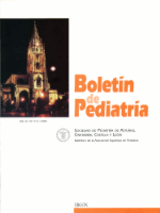Intoxicación por plomo en el occidente asturiano (II): Tratamiento quelante con ácido 2,3-dimercaptosuccínico (DMSA)
C. Loza Cortina
Bol. Pediatr. 2000; 40 (171): 33 - 38
Objetivo: Valorar la respuesta al tratamiento quelante con ácido dimercaptosuccínico (DMSA) en niños con una intoxicación por plomo de modera a severa y comparar la evolución de uno de ellos con el caso de un niño que no recibió tratamiento. Pacientes y métodos: Se revisaron retrospectivamente los casos de tres niños sometidos a tratamiento quelante con DMSA, de 9, 3 y 1 años de edad. La evolución del caso de un año de edad se comparó con la de otro de siete meses de edad que no recibió tratamiento. Periódicamente, se hacían controles analíticos en sangre y orina para evaluar distintos parámetros (plomo, zinc protoporfirina, ácido gamma amino-levulínico, coproporfirinas, etc.). Resultados: Dos de los pacientes, los más jóvenes, respondieron a la primera tanda de tratamiento, con una reducción del plomo tras el rebote del 28 y el 33%, mientras que el tercer paciente, con una reducción del 19%, no respondió. El tratamiento fue muy bien tolerado en los tres casos. A los diez meses, la diferencia entre la disminución de la plumbemia del caso tratado y no tratado era mínima, del 59 y 52%, respectivamente. Conclusiones: El tratamiento quelante con DMSA en niños con intoxicación por plomo es eficaz y bien tolerado. Al comparar el perfil de las plumbemias al cabo de diez meses entre dos casos de edades similares, uno tratado y otro no tratado, surge la duda en cuanto a la necesidad de iniciar o no el tratamiento de forma inmediata, aunque, naturalmente, al tratarse solamente de dos casos, esta aseveración ha de permanecer en el terreno de las conjeturas. Abstract Objective: To assess the response to chelation therapy with dimercapto-succinic acid (DMSA) in children with moderate to severe lead poisoning and to compare the evolution of one of them with the case of a child who did not receive any treatment. Patients and methods: We reviewed retrospectevely the cases of three children who received chelation therapy , of 9, 3 and 1 years of age. The evolution of the one-year old case was compared with that of a seven-month old infant who did not received any treatment. Periodically, blood and urine analytic controls were carried out to evaluate different parameters (lead, zinc protoporphyrin, gamma aminolevulinic acid, coproporphyrins, etc.). Results: The two youngest patients responded to the first course of treatment, with a blood lead reduction after the rebound of 28% and 33%, whereas the third patient, with a reduction of 19%, did not respond. All three cases tolerated very well the treatment. Ten months later, the difference between the blood lead reduction in the case treated and and not treated was minimal, 59% and 52% respectively. Conclusions: Chelation therapy with DMSA in children is effective and well tolerated. When we compare the lead profile after ten months between two cases with similar age, one treated and the other not treated, doubts arise regarding the convenience of starting the treatment immediately, although, being only two cases as they are, this assertion must be considered as a conjecture.
\N
\N
Artículo completo (PDF) (27 kb.)
- Pediatría Social
